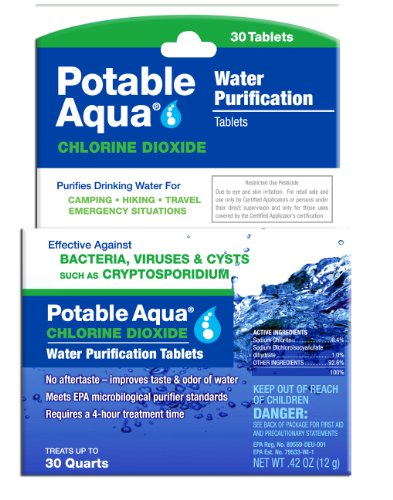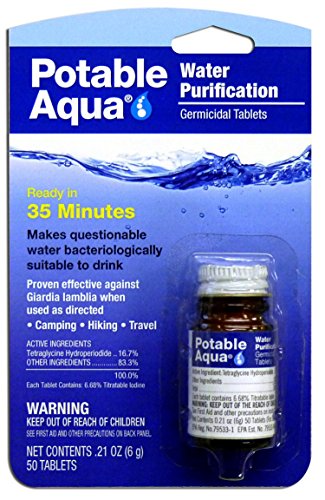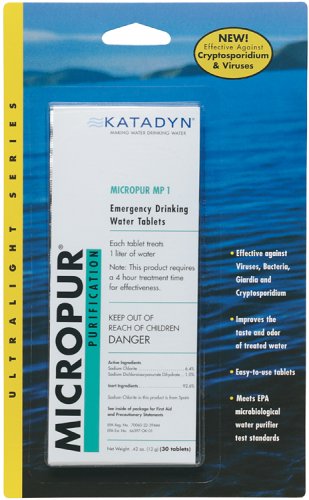At some point during a hiking career (or hobby), we all start seeking the best water purification tablets for backpacking. Unfortunately, there are tons of ways to purify water and everyone has an opinion, so what gives?
I honestly can’t remember what I used first – Potable Aqua or a Katadyn Hiker filter. It’s been too long ago. Maybe that’s a testament more to my short memory than old age, though. It couldn’t have been more than 12 years ago. Shhh… don’t tell!
Of course, since then I actually became a professional outdoor educator and guide and learned a few things. But, hey, who needs that degree anyways?
As I mentioned, there are many ways to make water safe to drink. Today we’ll be focusing exclusively on purification tablets which, technically are a form of chemical purification. The ultimate goal? To neutralize the nasties in your water so you don’t crap your brains out for a week of hiking!
Doesn’t sounds so good when you put it that way, does it? Guess we better figure out which ones are the best, then!
Comparison Chart
Name | Price | Time to Purify | Rating | Notes |
|---|---|---|---|---|
$6.15 / 30-day trip | 30 min | Active Ingredient: Hypochlorous Acid; not effective against Crypto | ||
$124.80 / 30-day hiking trip | 4 hours | Active Ingredient: Chlorine Dioxide; effective against Crypto | ||
$124.74 / 30-day hiking trip | 4 hours | Active Ingredient: Chlorine Dioxide; effective against Crypto | ||
$67.19 / 30-day hiking trip | 30 min | Active Ingredient: Tetraglycine Hydroperiodide (TGHP; not effective against Crypto | ||
$124.28 / 30-day hiking trip | 4 hours | Active Ingredient: Chlorine Dioxide; effective against Crypto |
How to Choose the Best Water Purification Tablets
What is Water Purification?
Water purification, when it comes to backpacking, is any means of sterilizing water found in nature and making it safe for consumption. There are many ways to do this but they can be broken down as follows:
Purification is any form of making water safe to drink.
There are actually many other methods of water purification that we aren’t going to talk about because they’re not easily achievable in a hiking situation. Also, I’m not an expert in water purification sciences so I don’t want to get over my own head here.
For this article, we’ll focus on chemical purification through the use of tablets.
How do Water Purification Tablets Work?
Good question. We’ll keep it broad scope for this topic.
Purification tablets are highly concentrated forms of chemicals. When introduced to a limited quantity of water, they dissolve and kill living organisms in the water which could otherwise harm you.
There are various types of chemicals which can be used in tablet form. Further, I want to distinguish them from liquid chemicals like bleach and chlorine dioxide (Aquamira) that can be used for this purpose.
Are Water Purification Tablets 100% Effective?
Negative. They are not.
Some tablets are better than others – in that they can kill a broader amount of organisms. However, even those which are capable of killing all dangerous organisms aren’t necessarily 100% effective.
Cloudy water (water that has sediment) can harbor little micro-pores where bacteria or viruses can hide away protected in the invisible little caves of floaties in the water. On a microscopic level what’s happening is that these little organisms are able to actually get away from the chemicals by sneaking inside tiny cracks, holes, and cavities in the floating debris in the water.
In order to make purification more successful, first, filter the water to remove sediment.
This is true for any form of purification. Use a bandana, filter pump, cheesecloth, or any other form of filter to remove the sediment. Using certain types of filters will remove the sediments and the harmful organisms in one pass and you won’t need chemical purification to back it up.
However, since we’re talking about using tablets, which are chemical, it’s safe to assume that you’ll only be using a crude filter to strain out particularly sediment-ridden water like slot canyon bowls, murky trailside streams, or other suspicious water.
If you’re pulling water from a clean, clear source there’s no need to filter it first. You can skip straight to using the chemical purification.
NOTE: Just because water appears clear and clean does not mean that it is safe to drink.
What Won’t Purification Tablets Save Me From?
As we already mentioned, purification tablets won’t save you from sediment. You need to get rid of that first, then purify.
However, there’s a big component of safe drinking water that no amount of filtering and chemical purification can save you from.
Chemically contaminated or irradiated water cannot be made safe to drink with normal filtration and tablets.
Even after you strain the sediment out of your water and drop purification tablets in, irradiated or chemically contaminated water still won’t be safe to drink.
NOTE: Some very high-end filters have chemical-neutralizing components which can nullify some chemical contamination in your water.
You may be thinking, “Who cares, I don’t drink chemical or nuclear water anyways.”
You’d be right most of the time, but these contaminants can come from some surprising sources that you may hike near.
Mining tailings are a common source of chemical contamination like heavy metals such as lead or even uranium (which is radioactive). In fact, on a hike I’m planning just next month I noticed a warning for a stream I’ll be hiking near which warns of mining tailing contamination. I don’t carry anything that can neutralize these potential contaminants, so I have to be extra careful not to fill up there!
How Do They Taste?
Now that we’ve gotten the “education” section out of the way, let’s talk about the tangibles. Most articles you’ll read about water purification will start with this topic.
Chemical purification tablets are notorious for having bad flavors. This started with Iodine purified water.
Iodine has a heavy metallic taste and turns the water, along with any water bottles you own, permanently rusty brown or orange. I have several orange-stained bottles that still go out on the trail with me from years gone by.
Iodine is less popular these days for a couple reasons.
- Better tasting and more effective chemicals are now more common
- Iodine (such as the infamous Polar Pure) got restricted because of its nefarious use in drug-related activity
Chlorine Dioxide, in tablet form, has little or no taste. I don’t taste it, but maybe that’s just because my tongue has gone numb to it by now.
Potable Aqua while still available (last I checked) in just Iodine form, now is often sold with a taste-neutralizing chemical called PA+. It’s virtually tasteless.
Bleach is sometimes used as a water purification method. When properly diluted it does not have a taste or odor in my opinion (I use it).
NOTE: Bleach, when used as water purification, may have some chemical by-products but it is still recommended by the EPA as a water disinfectant.
How Long Does it Take To Purify My Water?
This is dependent on the chemical you’re using.
Every one of these is going to have a manufacturer recommended time frame. Just follow the directions and you’ll be good to go.
I’ll try to make a note in the reviews of the general wait time for purification to happen.
You have to wait for chemical purifiers to take effect because they’re not an instant method of purification like a filter. The chemicals take time to fully purify water and the more murky or sedimented the water, the longer this takes.
In general, your wait times will be from 20 minutes to 4 hours.
Giardia, Cryptosporidium, and All the Other Bad Guys
Chances are you’ve heard of Crypto and Giardia. These little dudes are tiny micro-organisms that will cause you no end of gastrointestinal upset. In some cases, this can be life-threatening usually in the form of dehydration due to vomiting and diarrhea.
I’ll be totally honest, when it comes down to it you should just take the manufacturer’s word for what each product will and won’t kill. That’s it.
In all of my research, however, I’ve only managed to find three main chemicals used in pretty much every chemical purifier:
Most of my research says that Chlorine Dioxide might kill Cryptosporidium but may take up to 4 hours to do so.
I mean the United States Center for Disease Control literally says, verbatim, “Disinfection with chlorine dioxide has a low to moderate effectiveness in killing Cryptosporidium.”
Meanwhile, manufacturer websites seem to claim various statements about the effectiveness of Chlorine Dioxide. For instance, the AquaMira Technical Information section for their water treatment drops states, “…chlorine dioxide kills protozoan cysts such as Cryptosporidium…” This statement seems to me to be in clear contradiction, at least to the average consumer, to the CDC’s stance that chlorine dioxide has a “low to moderate effectiveness”.
~It’s worth noting that Cryptosporidium is quite a rare contaminant in hiking water and is relatively easily treatable by doctors.~
What it really comes down to is that proper mechanical filtration or boiling are very likely to remove all of these things, while chemical purification may or may not.
I think it’s clear that the jury is still out in regards to the true effectiveness of chemical purification methods in various situations. Frankly, I’m left confused and feeling entirely unsure even after deeper research.
Packability
When it comes to hiking and backpacking, even the most useful purification is as good as useless if you can’t carry it.
Weight and bulk are the two primary factors at play when it comes to packability. However, every purification tablet I’ve ever encountered is clearly packable.
Even as an ultralight backpacker myself, I have to admit it might be a bit nit-picky to get too hung up on the minor weight differences between purification tablets. In the end, the effective differences are in the fractions of an ounce.
I’ll make a note of any real differences I find in packability when we get to the reviews.
Cost
Water purification tablets are expensive. So are filters, UV pens, and other methods.
I’ll do my best to compare the math using these criteria:
Assuming you drink 2 gallons of water per day on the trail and you’re on the trail for 30 days I will calculate the cost to purify water for each method where information is available.
I will try to point out any tablets on our review list that are particularly cheap, seemingly, or expensive compared to others. It will depend a lot on your exact methods and what other options you have for purification as to which exact method or product is the cheapest.
Best Water Purification Tablets for Backpacking 2019
I will say right up front, I had a hard time fully understanding how these little dudes work. However, I think this statement from the company’s own FAQ section answers it:
Each Aquatabs tablet contains a measured dose of Sodium Dichloroisocyanurate, commonly referred to as NaDCC. When added to water Aquatabs dissolve to release a measured dose of hypochlorous acid (free available chlorine) that is universally recognized as a safe and effective water disinfectant.
I’m not going to lie… I have no idea what the technical chemistry differences are between hypochlorous acid and the active ingredients in bleach (sodium hypochlorite) but from my limited knowledge, it sounds like they work similarly as a purification method.
According to the manufacturer, these tabs do not work against Crypto. For that reason, we’ll compare them to Iodine.
- Hypochlorous Acid
- $6.15 per 30-day trip
- 30-minute wait time
According to the manufacturer, a 100-pack can treat 200 liters of water. With that math, it makes AquaTabs the clear winner in terms of pricing.
The next cheapest method, Iodine tablets, are still more than 11x more expensive than Aquatabs!
Potable Aqua has to be one of the most established names in water purification tablets. They’ve been doing iodine tablets for as long as I can remember.
However, now they’re making Chlorine Dioxide tablets and that’s a good thing for us. Remember that iodine won’t kill Crypto but chlorine dioxide will, so that’s why these tablets came up first on our list.
- Chlorine Dioxide
- $124.80 per 30-day hiking trip
- 4-hour wait
At over half a dollar per tablet, this is not a cheap way to clean up your water. However, it will give you some edge over Crypto and those cheaper methods might leave you crapping your brains out beside the trail.
It’s worth noting now that these tablets come in a hard-sided little bottle to protect them.
AquaMira has long been one of my favorite water treatment methods. In fact, their liquid Chlorine Dioxide treatment was my method of choice before I switched to household bleach myself.
There’s not a lot of difference between these tablets and the Potable Aqua we just looked at so, in my opinion, it comes down to cost. When you’re on the trail for a long hike, like a 6-month thru-hike, the cost could be $500 or more for some methods!
- Chlorine Dioxide
- $124.74 per 30-day hiking trip
- 4-hour wait
Apparently, when it comes down to the nuts and bolts, there’s really no difference between the AquaMira and Potable Aqua chlorine dioxide tablets. They work on the same chemicals and cost the same.
However, there is one big difference. AquaMira tablets come in a heavy-duty plastic bag while Potable Aqua comes in a hard-sided bottle.
Since the tablets are potentially crushable, the Potable Aqua hard sided bottle eeks out a win.
Let’s take a little look at the Iodine version of Potable Aqua. These classic tablets have been around ages and I think I even still have an old bottle in my hiking tote.
- Iodine
- $67.19 per 30-day hiking trip
- 30-minute wait time
While the cost is about half of the first two, remember that it won’t work on Crypto. However, if you read our full guide earlier, you know that even chlorine dioxide based treatments, like those on our list, are only moderately effective according to many reliable sources.
Without a definitive answer to go on, the ultimate choice is up to you. Do you want something half the cost with no chance of treating Crypto, or something twice as expensive with a moderate chance of treating Crypto?
I’ll leave it up to you.
NOTE: Use two tablets per liter of water (that number was factored into our cost equation).
Now we’re pulling full circle back to Chlorine Dioxide based tablets. This time from Katadyn, the tablets are made by a company who has been manufacturing reputable purification for backpacking for years.
- Chlorine Dioxide
- $124.28 per 30-day trip
- 4-hour wait time
Right off the batt, I have to say the advertising was a bit misleading. While different numbers are listed for bacteria, viruses, and Giardia but I had to search a bit to find, “This product requires a 4 hour treatment time for effectiveness.”
Nowhere did it clearly list a Cryptosporidium treatment time, but in the product description it was happy to state, “And the only disinfection system effective against viruses, bacteria, Cryptosporidium, and Giardia.”
Again, I think this just speaks to overall confusion and lack of clarity around the effectiveness of various treatments against Crypto but in the end, it’s about the same cost and effectiveness as any other Chlorine Dioxide treatment.
Conclusion
In the end, there’s a lot of to-do around what method of water purification is best. Of course, getting sick is no joke and dying of dehydration isn’t to be trifled with.
However, hopefully, we’ve made you more aware of how common some often-cited infections can be. You should now know which treatment tablets are effective (or maybe you’re just confused like me) and which ones fall short.
It’s up to you to decide if you want cheap, expensive, fast acting, or slow. We’ve taken a deep look at exactly what your options are for chemical tablet purification when it comes to backpacking water treatment.
Ultimately, it seems, if you’re really worried about Giardia and Cryptosporidium you’ll have to fall back on methods other than chemical treatments (or in combination with) if you want to be 100% sure you won’t get that nasty little bug.










